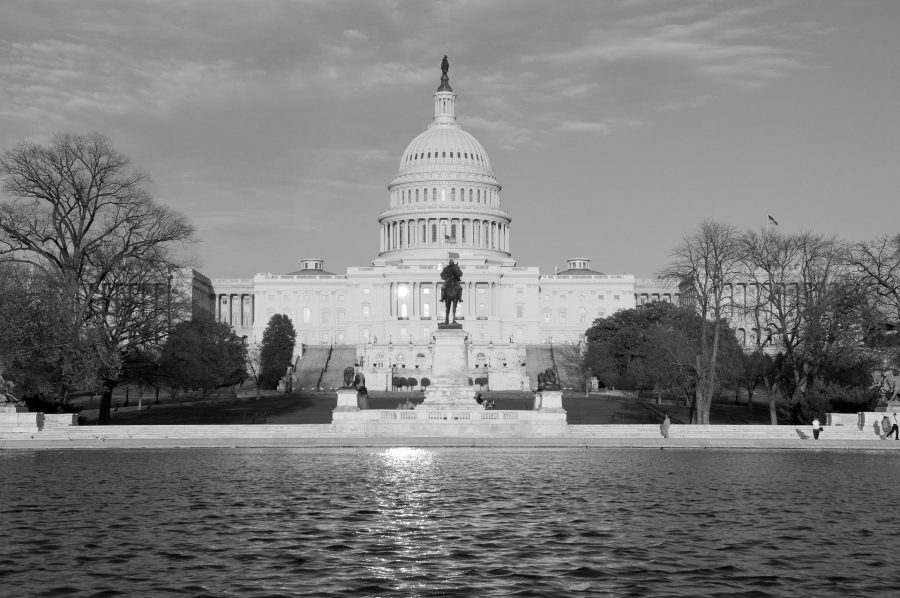President Trump’s schedule (EDT):
11:00 AM: Participates in a conversation at the Business Roundtable quarterly meeting; and
3:15 PM: Signs an executive order on improving free inquiry, transparency, and accountability on campus.
More in last night’s Wall Street Journal article.
This morning’s Politico Playbook:
SCOOP … TRACKING TRADE, THE PRESIDENT’S TOP PRIORITY … THE WHITE HOUSE has invited House Republicans on the USMCA — new NAFTA — whip team to meet with PRESIDENT DONALD TRUMP next week. The invitations went out Wednesday to a few offices on Capitol Hill. The meeting will be Tuesday at 3:15 p.m., and it is restricted to members of Congress.
TRUMP’S personal involvement here is a new dynamic, and it’s notable. Some people in the White House pushed back on us last week when we asked when the president would get involved. He’s now getting involved, speaking to a small group of Republican members about his top legislative priority.
“Trump Says Tariffs on Chinese Goods Will Stay for ‘Substantial Period of Time.’” This morning’s Wall Street Journal article leads with:
WASHINGTON—With the U.S. and China preparing for a fresh round of face-to-face negotiations, President Trump said the U.S. expected to keep tariffs on Chinese goods in place for a “substantial period of time,” even after a deal.
“We have to make sure that if we do the deal with China that China lives by the deal,“ Mr. Trump told reporters as he left Washington for Ohio. Administration officials have talked of removing tariffs in stages, as Beijing shows that it has carried out parts of a deal—and reimposing them if China later backtracks.
The details of a tariff rollback are the subject of ongoing negotiations, as are questions about enforcement, technology transfer, cross-border data flows and other issues.
U.S. Trade Representative Robert Lighthizer and Treasury Secretary Steven Mnuchin are planning to fly to Beijing for talks next week with Chinese Vice Premier Liu He. The two sides hope to wrap up a deal by the end of April.
Mr. Trump said “top representatives” are flying to Beijing for negotiations. On Thursday, China’s Ministry of Commerce said Messrs. Lighthizer and Mnuchin would visit Beijing on March 28 and 29 to continue trade talks. The ministry also said Mr. Liu would visit Washington early next month.
The President didn’t explain whether the U.S. is pressing to keep in place tariffs on all the $250 billion of Chinese goods the U.S. has hit with levies, or some portion of them, nor did he indicate for how long.
U.S. negotiators have divided the tariffs into two kinds. They are more willing to roll back at least some of the 10% tariffs on $200 billion of Chinese goods, which took effect in September as the U.S. tried to put more pressure on China.
But they are resisting removing the 25% on $50 billion of Chinese goods levied, in two stages, in July and August. Those tariffs were meant to compensate the U.S. for what the White House calculated was the harm to U.S. companies caused by China’s forced technology transfers.
“Gas-Tax Hike: A Rare Big Idea With Bipartisan Backing.” Yesterday morning’s Wall Street Journal article led with:
The U.S. Chamber of Commerce isn’t exactly a hotbed of pro-tax sentiment. So when the chamber advocates for a tax increase, it’s worth sitting up to take notice.
That’s what’s happening now. Chamber President Thomas Donohue told Congress this month [March 6th House Ways and Means hearing] that the chamber advocates raising the federal tax on a gallon of gas, which stands at 18.4 cents, by 25 cents over the next five years to produce funds desperately needed to fix the nation’s transportation network, and perhaps kick-start a broader effort to upgrade America’s infrastructure.
The gas tax has been the same since 1993, Mr. Donohue noted. “How many people in this room can live off the same paycheck you earned in 1993?” Mr. Donohue asked the House Ways and Means Committee. “No one? Our nation’s roads, bridges and transit systems can’t either.”
The chamber actually has been pushing a gas-tax increase since last year, but now it stands as a rare bird in today’s Washington: a big idea that has bipartisan support. More than that, it also represents a test case in whether a divided capital awash in trivial controversies and angry Twitter-fests can manage a serious debate on an important policy idea.
Actually, the gas tax is worth less than it was in 1993, and not just because inflation has eroded 40% of its value. Cars and trucks now get far better gas mileage, meaning they burn fewer gallons of gas to travel the same miles, meaning the tax’s contribution to the nation’s infrastructure is going down.
As a result, the federal Highway Trust Fund is going broke. It is running at an annual deficit, and Congress has been transferring in money from sources other than the gas tax to keep it solvent. If it seems the nation’s roads and transit systems are getting worse and draining economic efficiency, that’s one reason why.
That hardly means a gas-tax move is a slam dunk, of course. Conservatives are wary of any tax increases, and many liberals dislike gas taxes in particular because they can be regressive, falling disproportionately on lower-income citizens.
Still, the idea is alive because of a widespread belief that the nation’s infrastructure is worn out and out-of-date, and that, in a time of trillion-dollar annual federal budget deficits, there simply aren’t many places to get the $400 billion or so a gas tax would raise over the next decade. “Anybody got an idea of where else to get that kind of money?” Mr. Donohue asks in an interview.
In 1983, I was one of many advocating indexing of the federal motor fuels taxes, but, even though we had indexed much of the income tax in 1981, members of Congress refused to go along for fear of voter retribution. Now that our roads and bridges are falling apart, we’re finally waking up. Enactment of an infrastructure bill this spring will depend crucially upon a bipartisan agreement on how to fund it. I expect it to be partially funded.
“Complexity of the VAT in Europe.” Today’s Tax Foundation analysis stated:
This week’s tax map shows the number of hours it takes businesses across Europe to comply with the Value-Added Tax.
The Value-Added Tax (VAT) is considered one of the most efficient and neutral forms of taxation. When designed with a low rate and a broad tax base, it limits economic distortions while raising sufficient tax revenue. However, complying with the VAT can be complex due to provisions such as reporting and invoice disclosure obligations, requiring businesses to devote resources to tax compliance instead of other productive activities.
I applaud this Tax Foundation analysis. As approximate as it may be, it highlights a vital fact often lost in the tax debate — elected officials invariably complicate any tax system. Just because a value-added tax starts out simple on paper doesn’t mean it can’t become just as complicated as an income tax. Of any of you who do you own U.S. individual income taxes this year using software or not, do you find it easier than last year? Just because the 1040 has been contorted into a half-page “postcard” with 6 schedules, it’s no less complicated.
“H-4 Visas and Immigration Policy.” Yesterday’s blog by the American Action Forum’s Doug Holz-Eakin made an excellent point often lost in the immigration debate — immigration is pro-growth:
A new paper by AAF’s Jacqueline Varas makes an important point about those H-4 visa holders, finding that they are more highly educated and have higher earnings on average than the overall U.S. working population. They also tend to be concentrated in software developer occupations and in the professional, scientific, and technical services industry. She estimates that H-4 workers contribute an estimated $12.9 billion to the U.S. economy each year and, if every eligible H-4 visa holder were to obtain employment authorization, their economic contributions could increase to roughly $41 billion per year. With a current unemployment rate of only 2.2 percent for individuals with a bachelor’s degree or higher, it is unlikely that there are enough U.S. workers available to fill the jobs that would be left open. Therefore, it is possible that removing H-4 visa holders from the labor market could reduce current GDP by up to $13 billion and potential GDP by up to $41 billion per year.
That’s the debate in a nutshell. Should immigration be scaled back, even at a cost to the broader economy? Or, should immigration policy be one element of a larger pro-growth policy?
“Overview Of The Federal Tax System As In Effect For 2019.” Yesterday’s 36-page Joint Committee on Taxation pamphlet summarizes the 2019 tax system and provides 10 charts and tables showing revenues by source and the tax burden by income class.
“Answers to Questions for the Record Following a [January 29, 2019] Hearing Conducted by the House Committee on the Budget on [CBO’s] The Budget and Economic Outlook: 2019 to 2029.” Yesterday’s 4-page response by Congressional Budget Office Director Keith Hall contained answers to members’ questions on the budgetary effects of ObamaCare, immigration, and taxing greenhouse gas emissions.







